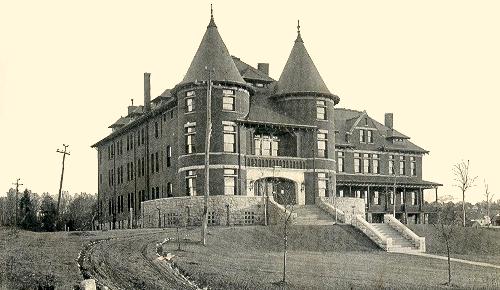 |
History of Scranton, Pennsylvania |
 |
History of Scranton, Pennsylvania |
David Craft, William A. Wilcox, Alfred Hand, J. Wooldridge. Published for H. W. Crew by the United Brethren Publishing House, Dayton, Ohio. 1891.
Page 255 to 256
The Capouse Works of Pulaski Carter were established in 1840, by Jerison White. This was the first edge tool factory started at Capouse. Soon afterward Mr. White sold out to Mr. Carter and removed to Providence where he erected a second factory, which, together with his dwelling, was swept away by a flood. Mr. White then built a small, rude shop, placing a bellows therein, and with the assistance of a boy began business on a small scale. In 1847 he built a larger factory and occupied it until 1861, when he sold out to his nephew, Crandall White, who conducted it for some time during the war. After the war was over Edward H. White and his father, J. White, were taken into partnership, and the business was resumed. In 1874 they removed to Green Ridge Avenue, and carried on the business there until 1878, when they abandoned it altogether. This establishment enjoyed the highest reputation, their specialty, axes, being made of the best Sheffield steel, tempered by a process that was original with the original proprietor.
Returning now to the establishment of Pulaski Carter, which
became his
in 1841, it may be stated that Mr. Carter was then a young man, from
Windham
County, Connecticut, who rented the recently erected shop of Jerison
White,
and in the fall put in three trip hammers and three forges, all of
which
he sent to work at once, and soon afterward purchasing the property, he
established what became widely and favorably known as the "Capouse
Works."
In 1841 he employed three hands, who together with him, made up three
and
a half tons of iron into one hundred and eighty dozen scythes, and one
hundred and sixty dozen axes, which were ground, polished, boxed, and
sold
by Mr. Carter himself. These implements were of superior quality, and
were
highly satisfactory to the pioneers of this section. The shop which was
then only one building, has given place to a group of more than thirty
buildings. In 1877 Mr. Carter’s partners were Calvin Parson,
of Wilkes-Barre,
and Edward Weston, of Providence. In this year Mr. Carter fitted up a
rolling
mill, which was designed to manufacture bar iron from scrap iron of
every
kind of shape. These works are still in existence, and are doing a
prosperous
business. [Another Carter history.]
Chapter XVIII, Public Institutions

Page 493 to 494
The Home for the Friendless was established in 1871. The immediate reason for its establishment was that the city missionary found a sick and helpless woman on the street at night, and the necessity for her protection and care led to the establishing of an institution which has ever since been a noble charity in the city. C. R. Mossman was the city missionary at the time, and those most intimately connected with the establishment of this charity besides him were Dr. S. C. Logan, Col. H. M. Boies, and Theodore Roe. A call was soon issued by members of the Young Men’s Christian Association which resulted in a meeting of ladies at the rooms of the association on September 27th of that year. The object was to inaugurate a movement in behalf of friendless women and children in the city. At this meeting a board of directors was elected, and at a second meeting held on the 29th of the same month, a constitution and by-laws were read and the board of managers increased from ten to twenty. The following named ladies were chosen a board of managers: Mrs. O. P. Clark, and Mrs. C. H. Wells, of Hyde Park; Mrs. H. S. Pierce,, Mrs. J. J. Wright, Mrs. I. L. Post, Mrs. J. C. Platt, Mrs. C. F. Mattes, Mrs. W. J. Crane, Mrs. O. B. Powell, Mrs. Horace Ladd, Mrs. R. A. Squire, Mrs. Kate Barnard, Mrs. O. McKune, Mrs. E. Phinney, and Mrs. Sivelly Reed. A house containing eight rooms, situated at the corner of Franklin Avenue and Linden Street, had already been temporarily leased and partially furnished, with money provided by the directors of the city poor, and seven women and nine children were admitted. A committee of ten ladies was chosen to take steps for the complete organization of the society, which now has the name of "The Society of the Home for the Friendless Women and Children of the City of Scranton." Mrs. W. G. Ward then contributed $50.00 toward the objects of the Home, which entitled her to life membership.
A meeting was held October 6, 1871, at which the constitution approved by the committee on organization was sanctioned. At this meeting fifty ladies became members, three of them for life, by the payment of $50.00 each. Annual members were required to pay $3.00 each. The society then selected the following officers: Mrs. C. H. Doud, president; Mrs. Thomas Moore and Mrs. C. F. Mattes, vice presidents; Mrs. William Breck, corresponding secretary; Mrs. L. B. Powell, recording secretary, and Mrs. H. B. Rockwell, treasurer. Boards of managers were then chosen – eight ladies for three years, eight for two years, and eight for one year. According to the first annual report of the treasurer, the income for that year was $1,787.24, and the expenses, $834.79.
In April, 1872, the Home was removed to a house near the corner of Jefferson Avenue and Linden Street, and on October 26, 1873, the society was incorporated under the name given above. Afterward some lots were secured on Adams Avenue and in 1874 a substantial and conveniently arranged building was erected at a cost of somewhat more than $8,000.
In 1884 the building was enlarged by the addition of a wing, the rooms in the three stories of which were thereafter devoted to the aged and sick. The officers of the society, since the expiration of the terms of those mentioned above, have been as follows:
The expenses of the Home for the years for which reports could be obtained, have been as follows: Year ending October 11, 1873, $1,873.13; year (fifteen months,) ending January 4, 1875, $1,295.65. During this time $4,688.18 was paid out on account of real estate. Year ending January 10, 1878, $2,971.89; ending January 9, 1879, $2,896.97; ending January 9, 1880, $2,962.07; ending January 12, 1882, $2,537.50; ending January 11, 1883, $2,294.13; ending January 11, 1884, $2,826.58; ending January 9, 1885, $3,770.09; ending January 7, 1886, $2,672.77; ending January 13, 1887, $2,927.90; ending January 11, 1888, $3,215.88; ending January 10, 1889, $3,621.61; ending January 9, 1890, $4,019.22; year ending January 8, 1891, $2,737.73.
Return to Index of History
Return to the Lackawanna County PAGenWeb Home Page